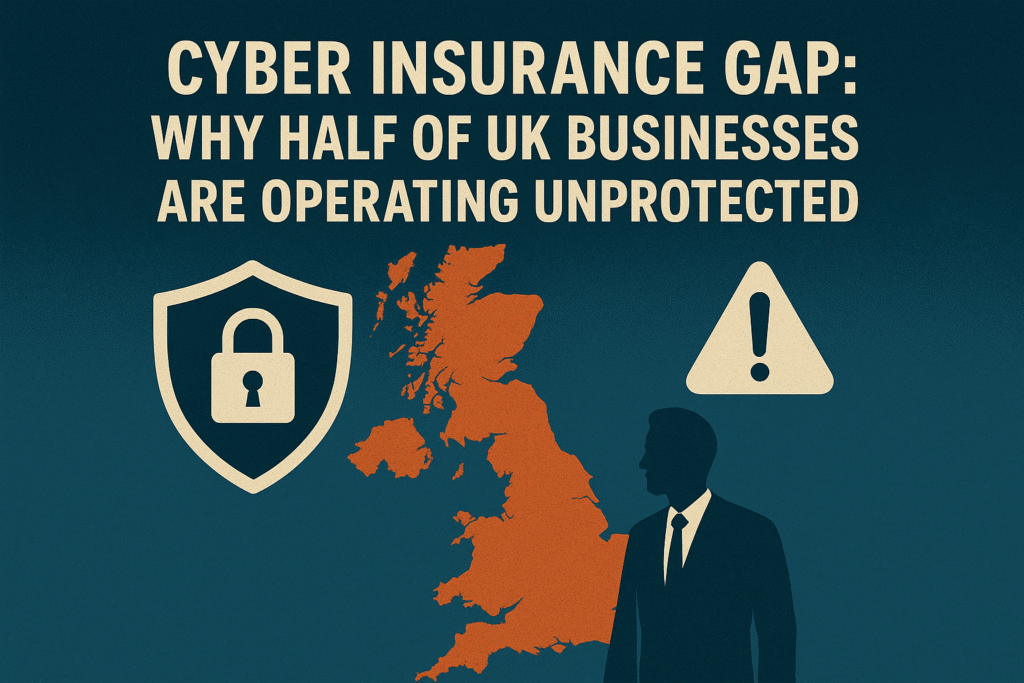A shocking cyber insurance gap is leaving UK businesses exposed. Discover why 50% have no coverage, the massive risks they’re taking, and how to navigate the complex market to secure your company’s future.
A Ticking Time Bomb in British Business
Imagine a silent, digital pandemic sweeping through the UK economy. It doesn’t make headlines like a recession, but its symptoms are everywhere: frozen computer systems, stolen customer data, paralysed operations, and crippling financial demands. This is the reality of the modern cyber threat landscape. In response, a critical financial vaccine has been developed: cyber insurance. Yet, astonishingly, approximately half of all UK businesses are choosing to operate without it, creating a dangerous and widening cyber insurance gap.
This isn’t a niche problem for tech firms. From the local solicitor’s office holding client details to the manufacturing plant run by automated systems, every business connected to the internet is a target. This protection gap represents a fundamental failure in risk management that threatens not just individual companies, but the stability of supply chains and the broader UK economy.
This article will serve as a urgent wake-up call and a practical guide. We will dissect the causes of this massive cyber insurance gap, explore the catastrophic financial consequences of being uninsured, demystify the complexities of the insurance market, and provide a clear, step-by-step action plan for business leaders to secure the coverage they desperately need before it’s too late.
The Scale of the Problem – Mapping the UK’s Protection Void
The statistics paint a stark picture of a nation playing digital Russian roulette.
The Data of Denial:
Recent studies from the UK’s Department for Science, Innovation & Technology (DSIT) and industry bodies like the Association of British Insurers (ABI) consistently show that despite a dramatic rise in cyber attacks, adoption of specialised cyber insurance remains staggeringly low. While over 80% of large corporations have some form of coverage, the figure plummets when looking at Small and Medium-sized Enterprises (SMEs), which form the backbone of the British economy. This leaves millions of businesses—employing tens of millions of people—dangerously exposed.
The “It Won’t Happen to Me” Fallacy:
The core of the cyber insurance gap is a dangerous cocktail of optimism bias and a fundamental misunderstanding of the threat. Many business owners believe:
- “We’re too small to be a target.” (False: Automation means hackers target thousands of SMEs simultaneously.)
- “We have good IT security.” (Important, but not foolproof. Insurance is a financial backstop, not a security replacement.)
- “Our general business policy will cover it.” (Almost certainly not. Most exclude cyber risks entirely.)
This misconception is the first and largest barrier to closing the gap.
The High Cost of Doing Nothing – Consequences of the Coverage Gap
The financial impact of a cyber incident on an uninsured business is often terminal. The costs extend far beyond simply fixing a computer.
1. The Direct Financial Haemorrhage:
- Ransomware Payments: The average ransom demand in the UK has soared into the hundreds of thousands of pounds. While paying is discouraged by authorities, many businesses feel they have no choice to regain access to their systems.
- Business Interruption: This is frequently the largest cost. When systems are down, business stops. Revenue is lost, payroll must be met, and fixed costs continue to accrue. Days or weeks of downtime can easily bankrupt a healthy company.
- Data Recovery and System Repair: Hiring specialist cyber forensic firms to eradicate hackers, rebuild networks, and restore data is incredibly expensive, often costing tens of thousands of pounds.
2. The Regulatory and Legal Reckoning:
- GDPR Fines: The UK GDPR and Data Protection Act 2018 grant the Information Commissioner’s Office (ICO) the power to levy fines of up to £17.5 million or 4% of global annual turnover—whichever is higher—for a serious data breach involving personal data.
- Class Action Lawsuits: Affected customers, clients, or employees can sue for damages resulting from the exposure of their private information. Legal defence costs alone can be crippling.
3. The Reputational Collateral Damage:
How would your customers react if their personal data was stolen from you? The loss of trust and brand damage can be irreversible, leading to a mass exodus of clients and an inability to attract new business. This intangible cost often proves fatal long after the technical problem is solved.
An uninsured business must bear 100% of these catastrophic costs. For many, a single significant cyber incident is a extinction-level event.
The Barriers to Adoption – Why Businesses Aren’t Buying
Understanding the cyber insurance gap requires looking at the obstacles preventing businesses from getting covered.
1. The Complexity and Confusion Problem:
The cyber insurance market is notoriously complex. Policies are not standardised. Terms like “social engineering fraud,” “system failure,” and “bricking” have specific meanings. Business owners are often confused about what they are actually buying and fear paying for a policy that won’t pay out.
2. The Rising Cost of Premiums:
As cyber claims have exploded globally, insurers have sharply increased premiums and, crucially, tightened their requirements. This necessary market correction has priced some businesses out and made others balk at the cost without fully appreciating the value.
3. The Stringent Security Requirements:
This is a major catch-22. To get affordable coverage, insurers now demand proof of basic cybersecurity hygiene before they will issue a policy. Common requirements include:
- Multi-Factor Authentication (MFA) on all remote access and cloud services.
- Regular, tested, and offline backups.
- A patch management policy to keep software updated.
- Employee security awareness training.
Many businesses discover they cannot qualify for insurance without first making these investments, creating a perceived barrier to entry.
4. The “General Liability” Misunderstanding:
A pervasive and dangerous myth is that a standard business liability or property policy will cover cyber incidents. In almost all cases, these policies now contain explicit exclusions for cyber-related losses. Assuming you’re covered when you’re not is the biggest risk of all.
Demystifying Cyber Insurance – What Does It Actually Cover?
A robust cyber insurance policy (often called cyber liability insurance) is a comprehensive toolkit for responding to a disaster. It typically includes first-party and third-party coverage.
First-Party Coverage (Costs to your own business):
- Incident Response: Covers the cost of forensic investigators to find the breach, eradicate the threat, and restore systems.
- Business Interruption: Replaces lost income and covers ongoing expenses during the downtime.
- Ransomware Negotiation & Payment: Covers the cost of hiring professional negotiators and, if decided, the ransom payment itself.
- Data Recovery: Pays for the effort to restore corrupted or stolen data.
- Reputational Harm: May cover PR and marketing costs to rebuild your brand.
Third-Party Coverage (Costs to others):
- Regulatory Defence & Fines: Covers legal costs to defend against an action by the ICO and may contribute towards fines (where insurable by law).
- Legal Liability: Covers damages and legal costs if clients or customers sue you for failing to protect their data.
- Notification Costs: Covers the expense of legally required actions, such as mailing letters to affected individuals and providing credit monitoring services.
Bridging the Gap – A Step-by-Step Action Plan for UK Businesses
Closing your personal cyber insurance gap is a multi-step process that strengthens your business overall.
Step 1: Conduct a Cybersecurity Risk Assessment
You cannot insure what you don’t understand. Work with your IT provider or a consultant to identify your key assets (e.g., customer database, intellectual property), your vulnerabilities, and the most likely threats you face.
Step 2: Implement Foundational Security Hygiene (The “Price of Admission”)
Assume an insurer will ask for proof of these measures. They are non-negotiable best practices:
- Enforce Multi-Factor Authentication (MFA): On every possible account, especially email and cloud services.
- Maintain Rigorous Backup Discipline: Follow the 3-2-1 rule: 3 copies of data, on 2 different media, with 1 copy offline and offsite. Test restores regularly.
- Create an Incident Response Plan: A simple, documented plan for who to call and what to do if you are hit. This demonstrates preparedness to insurers.
Step 3: Work with a Specialist Broker
Do not try to buy this insurance online or from a generalist. A broker who specialises in cyber insurance is essential. They will:
- Translate your business operations into insurance needs.
- Approach multiple insurers to find the best coverage and price.
- Explain the fine print and ensure you understand the exclusions.
- Advocate for you in the event of a claim.
Step 4: Prepare for the Application Process
The application will be detailed. Be prepared to answer questions about:
- Your security controls (MFA, backups, encryption).
- Your policies (remote work, data handling, patching).
- Your revenue and what data you store (especially personal or financial data).
Honesty is critical. Any misrepresentation can void the policy.
Step 5: Continuously Review and Improve
Cyber insurance is not a “set-and-forget” product. As your business grows and changes, your policy needs to be updated. Annually review your coverage with your broker and continue to invest in improving your security posture, which can help lower your premiums over time.
Conclusion: From Gap to Guarantee
The UK’s cyber insurance gap is a clear and present danger to economic resilience. It is a product of misunderstanding, complexity, and cost concerns. However, the cost of doing nothing is infinitely greater. Cyber insurance is no longer a optional add-on for tech companies; it is a core component of responsible business leadership and financial planning in the digital age.
Bridging this gap requires a shift in mindset—from seeing cyber insurance as an unnecessary expense to recognising it as a critical investment in business continuity and survival. By taking proactive steps to improve security hygiene and engaging with the specialist insurance market, UK business owners can transform a vulnerability into a strategic advantage. The question is not whether you can afford the premium, but whether you can afford the devastating cost of being on the wrong side of the gap when the inevitable attack occurs. Don’t wait for a breach to be your wake-up call. Act now to protect everything you’ve built.


